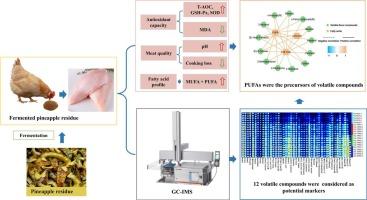Insight into the chemical composition, antioxidant capacity, meat quality, fatty acid profile, and volatile compounds of yellow-feathered chickens fed with fermented pineapple residue
IF 6.5
1区 农林科学
Q1 CHEMISTRY, APPLIED
引用次数: 0
Abstract
This study aimed to evaluated the effect of dietary fermented pineapple residue (FPR) on the chemical composition, antioxidant capacity, meat quality, fatty acid profile, and volatile compounds in yellow-feathered chickens. GC-IMS technique combined with multivariate analysis were performed to clarify the key volatile compounds. The results showed that dietary FPR improved meat quality by increasing the antioxidant capacity and pH value and decreasing cooking loss of breast muscle. The fatty acid profile was altered in breast muscle of chickens that fed with FPR. GC-IMS detected 43 volatile compounds in breast muscle, including mainly aldehydes, alcohols, esters, and ketones. Among them, 12 volatile compounds could serve as potential aroma markers to distinguish meat flavor of chickens fed with FPR. Correlation analysis revealed that C18:1n9c, C18:2n6, and PUFA are important contributors for meat flavor formation. In conclusion, dietary FPR improved antioxidant capacity, meat quality, fatty acid profile, and volatile compounds of breast muscle in chickens.

对用发酵菠萝渣饲喂的黄羽鸡的化学成分、抗氧化能力、肉质、脂肪酸组成和挥发性化合物的深入研究
本研究旨在评估日粮发酵菠萝渣(FPR)对黄羽鸡化学成分、抗氧化能力、肉质、脂肪酸组成和挥发性化合物的影响。研究人员采用气相色谱-质谱联用仪(GC-IMS)技术并结合多元分析,明确了主要挥发性化合物。结果表明,日粮 FPR 提高了抗氧化能力和 pH 值,降低了胸肌的蒸煮损失,从而改善了肉质。使用 FPR 饲喂的鸡的胸肌脂肪酸谱发生了变化。GC-IMS 在胸肌中检测到 43 种挥发性化合物,主要包括醛类、醇类、酯类和酮类。其中,12 种挥发性化合物可作为潜在的香味标记,用于区分饲喂 FPR 的鸡的肉味。相关分析表明,C18:1n9c、C18:2n6 和 PUFA 是形成肉香味的重要因素。总之,膳食 FPR 提高了鸡胸肉的抗氧化能力、肉质、脂肪酸组成和挥发性化合物。
本文章由计算机程序翻译,如有差异,请以英文原文为准。
求助全文
约1分钟内获得全文
求助全文
来源期刊

Food Chemistry: X
CHEMISTRY, APPLIED-
CiteScore
4.90
自引率
6.60%
发文量
315
审稿时长
55 days
期刊介绍:
Food Chemistry: X, one of three Open Access companion journals to Food Chemistry, follows the same aims, scope, and peer-review process. It focuses on papers advancing food and biochemistry or analytical methods, prioritizing research novelty. Manuscript evaluation considers novelty, scientific rigor, field advancement, and reader interest. Excluded are studies on food molecular sciences or disease cure/prevention. Topics include food component chemistry, bioactives, processing effects, additives, contaminants, and analytical methods. The journal welcome Analytical Papers addressing food microbiology, sensory aspects, and more, emphasizing new methods with robust validation and applicability to diverse foods or regions.
 求助内容:
求助内容: 应助结果提醒方式:
应助结果提醒方式:


